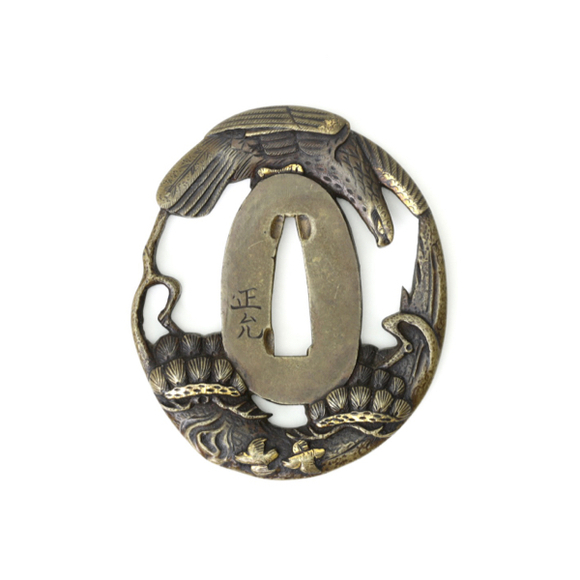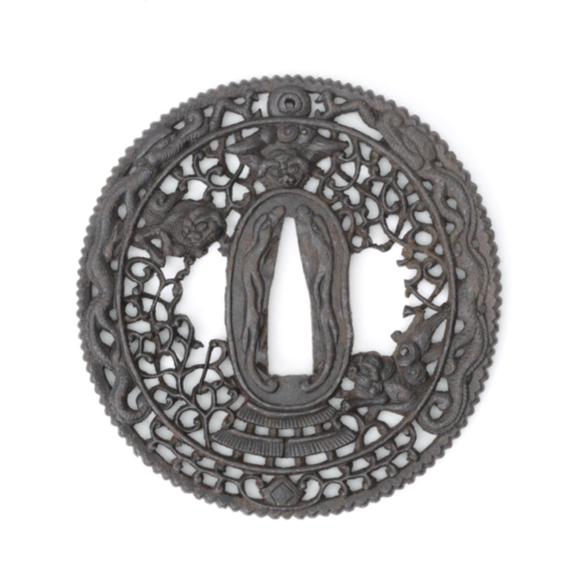Language: Japanese
Source: In common use
Description
Nakago (茎) is the Japanese word for the tang of a sword. It literally means "stem" or "stalk", like of a plant.
The word stems from a combination of the words komeru ("place or fit") and naka ("inside the hilt") together forming nakagomi, later abbreviated to nakago. In old sources it is written 茎, during the Edo period the writing 中心 became more popular.
The nakago is one of the most important elements of the Japanese sword as it is the only area of a sword that is not customarily polished and burnished, and so it is the only true sign of age. Moreover, it is an important reference point for kantei, the attribution of swords based on form and workmanship.
Parts of the nakago

Shape of the nakago
Nakago can be shaped in different forms. Most will have a fairly standard, slightly tapering form with a gentle curve that is an extension of the blade's curve.

Other known forms are:
Kijimono-nakago; "Pheasant's thigh", with a sudden narrowing to accommodate rivets in old hilts.
Oldest form. Primarily Heian to the mid-Kamakura period.
Saki-fuseru; Curved towards edge.
Saki-hosoru; Tapered tip.
Gohei-gata; Shaped like a Shintō sacred paper strip called gohei.
Introduced by Shintō-era smith Ise no Kami Kuniteru.
Sotoba-gata; literally "stupa shaped". The nakago barely tapers and ends in a V shape.
Mostly used by the Muromachi period Kongōbyōe smiths of Awa and Ise no Kami Kabayashi of Osaka.
Forms mainly seen on tantō:

Furisode nakago; "Kimono-sleeve".
Starting with Rai Kunitoshi and Awataguchi Yoshimitsu, also done by Norishige.
Fell out of favor at the end of the Kamakura period.
Funa-gata; "Ship shaped". (Also funazoko-gata).
Late Kamakura, beginning with Masamune.
Masamune, Sadamune, Gō Yoshihiro, etc., in combination with kengyō-jiri tip (see below).
Tanagobara; Grasshopper's belly.
Muramasa and his school. Muromachi period.
Nakago jiri
Their ends, jiri (尻) can be finished in several different ways:

Kiri; straight.
Often seen on swords of the Hōshō school.
The default finish on shortened swords.
Kurijiri; "chestnut tailed" rounded. Can be with or without sharp corners. When wide it is called kurijiri-hari, "expanded tang tail".
Most common method.
Ha-agari-kurijiri; rounded in an asymmetrical way, sloping on the edge side.
Kengyō-jiri; "sword-shaped tail", a V-shape with the nakago ridge in the center. Mainly Sōshū tradition and Shintō works in the Sōshū style.
Iriyamagata; a V-shape where the edge side is longer than the back side.
Kashū; like iriyamagata but with a very steep line on the edge side and almost straight at the back side. Usually seen on Kaga (Kashū) blades. Also called katasogi-nakago, "half removed tang" a more appropriate term when seen on non-Kotō blades like Yamato Shikkake.
Sotoba-gata; "stupa shaped".
Mostly used by the Muromachi period Kongōbyōe smiths of Awa.
State of the nakago
Blade shortening was very common in Japan, for a large part due to the sword regulations of the Tokugawa that stipulated set lengths for the swords that people we able to wear legally. Many larger tachi were thus shortened to katana length in the 16th and 17th centuries.
To keep the tempering of the tip intact the shortening was always done from the tang side. As a result, there are three basic states of the nakago:
Ubu; unaltered
Suriage; shortened, if there was a signature it may be (partly) preserved
O-suriage; greatly shortened, if there was a signature it is now lost
For collectors, ubu is of course the desired state but sometimes we don't have a choice when it comes to older blades. There are many great smiths, including Masamune, of whom not a single sword survived without being shortened or greatly shortened.
File marks, yasurime
Japanese sword tangs are typically finished with a special file, leaving marks called yasurime (鑢目). The marks can help in the dating and attribution of the sword. I drew some yasurime styles one can expect to encounter below.
Single direction yasurime

Kiri; Straight marks.
Most commonly seen, all schools and periods.
Katte sagari; Diagonal from upper left to lower right.
Second most common method.
Katte agari; Diagonal from upper right to lower left.
Sujikai; Steeply slanting from upper left to lower right.
Saka sujikai; Steeply slanting from upper right to lower left.
Ō-sujikai; Very steeply slanting from upper left to lower right.
Done coarsely on very old blades. Very neat and tidy on Ko-Aoe and Bizen Ichimonji.
Later mainly used by Aoe, Samonji, and Horikawa schools.
Saka ō-sujikai; Very steeply slanting from upper right to lower left.
Only on Shinto blades. For example Horikawa Kuniyasu, Iyo no Jo Munetsugu II and Mutsu no Kami Kaneyasu.
Two directional yasurime

Takanoha; "Hawk's feather". This and the saka takanoha may have originated due to the high shinogi on Yamato swords, making one continuous direction difficult to file.
Yamato and related schools.
Saka takanoha; "Reversed hawk's feather".
Yamato and Mino schools.
Kiri hiraji / katte sagari shinogiji; Straight on the edge facet, slanted on the back facet.
Katte sagari hiraji / kiri shinogiji; Slanted on the edge facet, straight on the back facet.
Higaki; a combination of sijukai and saka sujikai forming a mesh. Extremely difficult.
Mostly Yamato and Naminohira from the Kamakura period onwards. It was adopted in Mino during the Muromachi period up until the Shintō period. Some Shintō and Shinshintō smits still finished their tangs in this way but in a much coarser way, indicating loss of skill.
(Hokke Saburo Nobufusa of Sendai attempted it in recent times but had great difficulty with the method, as the second angle distorted the file marks of the first angle.)
Kesho yasuri

Kesho are cosmetic file marks in multiple directions, a rather late arrival on the scene it is seen only on Shinto blades and later. There are many varieties among the different schools and smiths.
Other nakago finishes
Tsuchime; Some nakago aren't finished with a file, but instead show hammer marks from forging called tsuchime. This is seen primarily on very ancient swords, or specially made ones.
Sensuki; "plane drawing". Some nakago are finished with a special plane, leaving irregular marks in the direction of the nakago. This is seen primarily on ancient swords, jōkotō to early kotō, on Muromachi period Mino swords and naginata and yari.
References
Markus Sesko; Encyclopedia of Japanese swords
Kokan Nagayama; Connoisseurs book of Japanese swords
N.B.T.H.K. Manual for appreciating the Japanese sword
Sato Kanzan; Kanzan's Japanese Sword Class 23. Published in Token Bijustu Volume 1.






